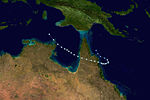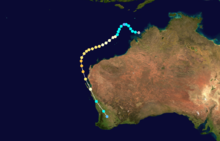- 1975–80 Southern Hemisphere tropical cyclone seasons
-
The 1975-1980 Southern Hemisphere tropical cyclone seasons ran year-round from 1 July to 30 June during each year between 1975 and 1980. Tropical cyclone activity in the Southern Hemisphere reaches its peak from mid-February to early March.
1975–76 Southern Hemisphere tropical cyclone season
Severe Tropical Cyclone Joan
Category 5 severe tropical cyclone (Australian scale) Category 4 tropical cyclone (SSHS) 

Duration 30 November – 10 December Intensity 230 km/h (145 mph) (10-min), 915 mbar (hPa) On the morning of 30 November 1975 satellite imagery showed a large cloud mass in the Timor Sea. The satellite photograph received on the morning of 1 December showed that significant organization had occurred in the cloud mass during the previous 24 hours. It was deemed at 0115 UTC that the system be named the developing cyclone Joan, located about 310 km west-northwest of Darwin. Joan's movement in the following 48 hours was towards the southwest at an average 5 km/h. The first evidence of the increasing strength of Joan came as the cyclone moved west-southwest past the northernmost areas of Western Australia on 3 December. The cyclone's generally west-southwesterly track after 2 December took it away from the coast until 0900 6 December when it was about 420 km north of Port Hedland and the system turned southward. At about 2200 UTC 7 December 1975 the eye of tropical cyclone Joan crossed the coast about 50 km west of Port Hedland. The cyclone was travelling south-southwest at about 14 km/h and crossed over or adjacent to the homesteads on the pastoral properties Mundabullangana, Mallina, Coolawanyah, Hamersley, and Mount Brockman. As cyclone Joan crossed the coastal plain and the Chichester Range only a slow moderation of its intensity seems to have occurred, but as the cyclone crossed the Hamersley Range the available evidence suggests that a rapid weakening took place.
Tropical cyclone Joan was the most destructive cyclone to affect the Port Hedland area in more than 30 years. The city was subjected to sustained winds exceeding 90 km/h for about 10 hours with winds in excess of 120 km/h for three hours. The maximum measured wind gust of 208 km/h on 8 December 1975 is the fourth highest on record in Australia. Severe property damage occurred at Port Hedland and at other settlements close to the cyclone's path. Subsequent flooding damaged roads and sections of the iron ore railways, particularly that of Hamersley Iron Pty Ltd. Sheep losses were heavy but, remarkably, no loss of human life or serious injury was reported. The estimated damage to private property and public facilities is believed to have exceeded $25 million. [1]
Cyclone Danae
Cyclone Danae struck Madagascar and then hit the east coast of Mozambique and South Africa in late January 1976. 50 people were killed in the flooding that resulted from the heavy rainfall of Cyclone Danae. WeatherSA Home: Johannesburg
1976–77 Southern Hemisphere tropical cyclone season
Cyclone Ted
Ted made landfall in Queensland on 1 January 1976. The storm killed 2 people and left $49 million dollars in damage.[2]
Cyclone Otto
Otto made landfall near Bowen, Queensland in March 1977. The storm caused minimal wind damage but caused extensive beach erosion.[3]
Cyclone Leo
Leo affected Port Hedland around March 1977.
Cyclone Emilie
Cyclone Emilie struck the east coast of Mozambique and northeastern South Africa in February 1977. Heavy flooding in the Limpopo Valley killed at least 300 people. [1] [2]
1977–78 Southern Hemisphere tropical cyclone season
Severe Tropical Cyclone Alby
Category 5 severe tropical cyclone (Australian scale) Category 4 tropical cyclone (SSHS) 

Duration 27 March – 5 April Intensity 205 km/h (125 mph) (10-min), 930 mbar (hPa) Main article: Severe Tropical Cyclone AlbyOn 27 March a tropical depression developed in the eastern Indian Ocean between Indonesia and Australia. It drifted to the southwest, and slowly strengthened into a tropical storm on the 29th. Alby continued slowly southwestward, and attained cyclone status on 30 March. The rate of intensification, which was slower earlier in its life, became more steady towards strengthening, and reached the equivalent of Category 3 status on 1 April. Tropical Cyclone Alby turned more to the south, and quickly reached a peak of 135 mph later on 1 April. After maintaining its strength for 30 hours, Alby weakened as it turned to the southeast. Its forward momentum increased over the southeast Indian Ocean, and Alby was only an 85 mph cyclone as it passed off the southwest coast of Australia on 4 April. It continued rapidly to the southeast, and became extratropical on 5 April while south of the continent.
On the 4th of April, Tropical Cyclone Alby passed close to the southwest corner of Western Australia, killing five people and causing widespread but mostly minor damage to the southwest. The damage bill was estimated to be $39 million (2003 dollars). A man was blown from the roof of a shed and a woman was killed by a falling pine tree. Another man was killed when a tree fell on the bulldozer he was operating and two men drowned when their dinghy overturned at Albany. Storm surge and destructive waves caused coastal inundation and erosion from Perth to Busselton, damaging the Busselton Jetty and Fremantle Harbour. Fires fanned by the strong winds burned an estimated 1,140 km² of forest and farming land.
1978–79 Southern Hemisphere tropical cyclone season
Cyclone Peter
Category 2 tropical cyclone (Australian scale) Tropical storm (SSHS) 

Duration 29 December – 4 January Intensity 90 km/h (55 mph) (10-min), 980 mbar (hPa) Peter caused extensive damage in the Gulf of Carpentaria between 1 January and 2 January 1979.[4] Peter hovered offshore, causing a 24 hour rainfall of 1140mm/44.88" at Mount Bellenden Ker on 5 January.[5]
Wettest tropical cyclones in Australia Precipitation Storm Location Rank (mm) (in) 1 1947 76.65 Peter 1979 Mt. Bellenden Ker[6] 2 1870 73.62 Rona-Frank 1999 Mt. Bellenden Ker[6] 3 1411 55.55 Mackay Cyclone 1918 Mackay 4 1318 51.89 Wanda 1974 Mt. Glorious[7] 5 927 36.50 April 1898 cyclone Whim Creek[8] 6 907 35.71 Feb. 1893 cyclone Crohamhurst[7] 7 900 35.43 Feb 1954 cyclone Springbrook[7] 8 759 29.88 Grace 2004 Topaz[9] 9 747 29.40 Neville 1992 Garden Point[10] 10 732 28.81 Carlos 2011 Darwin[11] Cyclone Kerry
Tropical Cyclone Kerry has the distinction of being the longest lived cyclone in the Australian region. It formed on 13 February 1979 and caused severe damage in the Solomon Islands. It then tracked across the Coral Sea making landfall near Mackay, Queensland on 1 March and dissipated on 6 March. Its lowest pressure was 955hPa.[12]
Cyclone Meli
Cyclone Meli struck eastern Fiji on 25 March. The island of Nayau suffered a direct hit and passed close to the islands of Lakeba and Cicia. Fiji suffered tremendous crop losses and 50 people were killed [13][14] On 27 March 1979, Cyclone Meli brushed Fiji at peak intensity, causing substantial damage to the island. At least 50 people were killed by the storm.[15]
Cyclone Meli had previously passed through Tuvalu damaging Funafuti atoll.
Cyclone Hazel
Hazel grazed the Western Australia coast on 1 March 1979. Fifteen crewmen drowned when their fishing boat sank during the storm.[16]
1979–80 Southern Hemisphere tropical cyclone season
Cyclone Amy
Cyclone Amy struck Western Australia as a Category 5 cyclone on 10 January 1980. Amy left $2.7 million dollars ($12 million 2005 AUD) in damage, and injured 5 people.[17]
Cyclone Hyacinthe
Tropical Cyclone Hyacinthe set several worldwide tropical cyclone rainfall records in Réunion in the Southwestern Indian Ocean, including a peak total of 5678 mm (223.5 inches).[18]
Tropical Cyclone Dean
Dean struck Western Australia a month after Cyclone Amy. Dean left $11 million (2005 AUD) in damage. It lasted from 26 January to 4 February 1980.[17]
Cyclone Enid
Enid lasted from 12 to 18 February 1980 and made landfall between Port Hedland and Broome, Western Australia (near Shay Gap) and caused flooding.
Cyclone Wally
Wally lasted in the southern Pacific from 1 April to 7 April and was a category one cyclone on the Australian tropical cyclone intensity scale with a peak pressure of 990 HpA/mbar. During its lifetime it made landfall on the second biggest island of Fiji - Viti Levu.
See also
- List of Southern Hemisphere tropical cyclone seasons
- List of notable tropical cyclones
External links
References
- ^ CYCLONE JOAN DECEMBER 1975 - BOM REPORT[dead link]
- ^ http://www.ema.gov.au/ema/emadisasters.nsf/54273a46a9c753b3ca256d0900180220/6f607788bb439cbfca256d3300057bbc?OpenDocument[dead link]
- ^ http://www.ema.gov.au/ema/emadisasters.nsf/54273a46a9c753b3ca256d0900180220/d77e2c313a5f5ba0ca256d33000580cf?OpenDocument[dead link]
- ^ http://www.ema.gov.au/ema/emadisasters.nsf/54273a46a9c753b3ca256d0900180220/dc55889c6a538e4dca256d3300057c69?OpenDocument[dead link]
- ^ Weather Rainfall Cyclones[dead link]
- ^ a b "Climate Education: Flood". Australian Bureau of Meteorology. 2010. http://www.bom.gov.au/lam/climate/levelthree/c20thc/flood.htm. Retrieved January 18, 2011.
- ^ a b c Bureau of Meteorology. Tropical Cyclones in Queensland. Retrieved on 2008-01-02.
- ^ Bureau of Meteorology. Tropical Cyclones in Western Australia. Retrieved on 2008-01-02.
- ^ Gary Padgett. Monthly Global Tropical Cyclone Summary: March, 2004. Retrieved on 2006-10-11.
- ^ "Tropical Cyclone Neville". Bureau of Meteorology. 2011. http://www.bom.gov.au/cyclone/nt/Neville.shtml. Retrieved 2011-02-15.
- ^ Dillon, Meagan (18 February 2011). "Wet season almost the wettest wet yet". Northern Territory News. News Limited. Archived from the original on 18 February 2011. http://www.webcitation.org/5wZLEIC6y. Retrieved 18 February 2011.
- ^ Bureau of Meteorology (1992). Climate of Queensland, Commonwealth of Australia ISBN 978-0-644-24331-5
- ^ http://www.gns.cri.nz/services/hazardsplanning/downloads/SR2006-038trad_mitigation_pacific.pdf[dead link]
- ^ http://www.basedn.freeserve.co.uk/cyclone.htm Archived August 28, 2008 at the Wayback Machine
- ^ Staff Writer (26 May 2000). "The British Association for Immediate Care: Cyclone". The British Association for Immediate Care. Archived from the original on August 28, 2008. http://web.archive.org/web/20080828040812/http://www.basedn.freeserve.co.uk/cyclone.htm. Retrieved 15 April 2009.
- ^ http://www.ema.gov.au/ema/emadisasters.nsf/54273a46a9c753b3ca256d0900180220/c96854d69c2d0932ca256d3300057bc8?OpenDocument[dead link]
- ^ a b http://www.idro.com.au/disaster_list/default.asp[dead link]
- ^ Météo-France (2007). "Avec GAMEDE et 27 ans après HYACINTHE, La Réunion bat ses propres records mondiaux de précipitations sur les durées de 3 à 9 jours" (in French). http://www.webcitation.org/5NWTMO1cn. Retrieved 2008-04-12.
Categories:- Hurricane articles without infoboxes
- 1975–80 Southern Hemisphere tropical cyclone seasons
Wikimedia Foundation. 2010.


